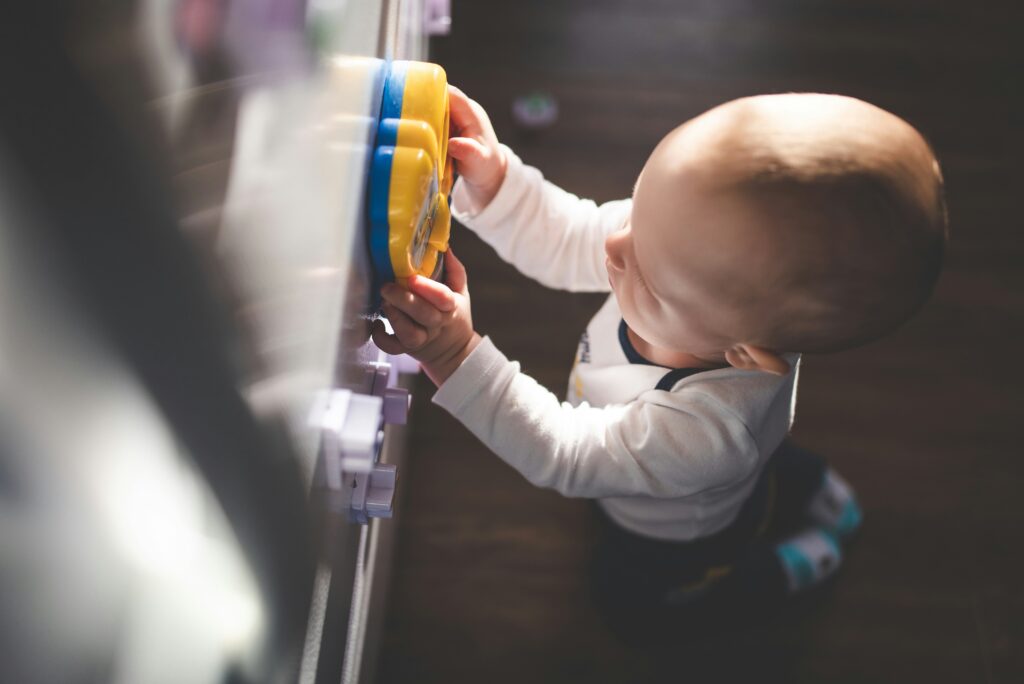
When your baby begins to crawl or walk, their curiosity becomes boundless and so does your need to ensure their safety. One of the simplest yet most effective tools to create a secure home environment is the baby gate. Baby gates help you control access to certain areas, preventing your little one from venturing into unsafe spaces like stairs, kitchens, or bathrooms. This guide explores everything you need to know about baby gates their types, installation tips, safety features, and practical buying advice to help keep your little explorer safe and happy.
1. Why Baby Gates Are Essential for Home Safety
Babies and toddlers are naturally curious. They want to explore everything within reach, but that curiosity can lead to accidents if boundaries aren’t in place. Baby gates provide a physical barrier, offering parents peace of mind.
- Preventing falls: Gates at the top and bottom of stairs stop accidental tumbles.
- Room restrictions: Keep children out of areas with sharp objects, electrical appliances, or cleaning chemicals.
- Pet separation: They can also help separate pets from infants when needed.
According to child safety experts, most household accidents among toddlers occur due to unrestricted movement—baby gates minimize that risk.
2. Types of Baby Gates: Which One Fits Your Home Best?
There isn’t a one-size-fits-all baby gate. The right choice depends on where you want to install it and how frequently it will be used.
a) Pressure-Mounted Gates
These gates use tension to stay in place between two walls or door frames. They are easy to install and move but not recommended for stair tops since they can loosen over time.
b) Hardware-Mounted Gates
These gates are screwed into the wall, offering a more secure fit ideal for staircases or permanent placement. They’re sturdier and provide peace of mind for long-term use.
c) Retractable Gates
Retractable mesh gates are space-saving and stylish. They’re great for doorways or hallways where you might not always want a visible barrier.
d) Freestanding Gates
Perfect for large spaces or open floor plans, freestanding gates can block off entire sections of a room without needing walls for support.
3. Key Features to Look for in a Baby Gate
When selecting a baby gate, focus on safety, durability, and convenience. Here are essential features to consider:
- Sturdy Construction: Opt for gates made of metal or hardwood for longevity.
- Height and Slat Spacing: The gate should be at least 22 inches tall with slats no more than 2.5 inches apart.
- One-Hand Operation: This feature is helpful when you’re holding your baby.
- Auto-Close Mechanism: Some gates automatically swing shut, adding an extra layer of security.
- Latch Safety: Choose a child-proof latch that adults can easily operate but toddlers can’t.
- Certifications: Look for safety certifications such as ASTM or JPMA, ensuring the gate meets tested safety standards.
4. Where to Install Baby Gates
Strategic placement makes all the difference. Common areas include:
- Top of stairs: Always use hardware-mounted gates here for maximum stability.
- Bottom of stairs: Either type works, but make sure it opens away from the steps.
- Kitchen entrances: Prevents toddlers from reaching hot surfaces or sharp tools.
- Bathrooms and laundry rooms: These areas often contain cleaning agents or water hazards.
- Play zones: Use gates to create safe play areas where you can supervise easily.
5. Installation Tips for Maximum Safety
Proper installation ensures your gate serves its purpose effectively.
- Always follow the manufacturer’s instructions carefully.
- Check that pressure-mounted gates are tightly secured and regularly readjust them if they loosen.
- For hardware-mounted gates, use the provided brackets and ensure they’re screwed into solid wood or wall studs.
- Make sure the gate swings open in the safest direction (away from stairs).
- Test the gate’s strength regularly to ensure it hasn’t weakened over time.
6. Common Mistakes to Avoid
Even the best gate can fail if installed or used incorrectly. Avoid these pitfalls:
- Using pressure gates at stair tops: This is one of the most common and dangerous mistakes.
- Leaving gates open: Always latch them after passing through.
- Improper height: Short gates can be climbed over as your child grows.
- Neglecting wear and tear: Replace gates with broken parts or loose fittings immediately.
7. Stylish Baby Gates for Modern Homes
Baby gates no longer need to clash with your décor. Modern designs combine safety with style:
- Wood-finish gates blend well with traditional interiors.
- Metal gates offer a sleek, contemporary look.
- Retractable mesh designs fit minimalist homes beautifully.
Choosing an aesthetic that matches your space can help you keep safety barriers in place without sacrificing style.
8. When to Remove the Baby Gate
There comes a time when your child no longer needs a gate. Typically, once your toddler reaches two to three years old and can safely navigate stairs under supervision, you can start phasing out gates. However, every child is different trust your instincts and observe their abilities closely.
9. Maintaining and Cleaning Your Baby Gate
Keeping the gate clean and functional ensures its longevity and hygiene.
- Wipe it regularly with mild soap and water.
- Inspect for loose screws or weakened tension mechanisms.
- Lubricate hinges if the gate starts creaking.
A well-maintained gate will stay strong and secure for years, especially useful if you plan to reuse it for future children.
10. Final Thoughts: Creating a Safe and Happy Home
A baby gate might seem like a small addition, but it plays a big role in building a safe and nurturing environment for your growing child. From preventing falls to keeping curious hands away from danger zones, baby gates are a must-have for every parent.
Remember, safety is not just about barriers; it’s about awareness, supervision, and making thoughtful choices. With the right baby gate, you can let your little explorer roam freely while enjoying peace of mind that they’re safe.


